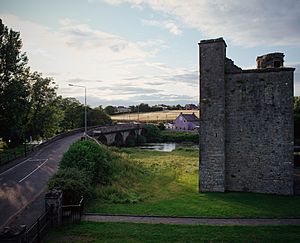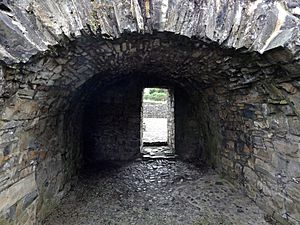St. John's Priory, Trim facts for kids
| Prióireacht Naomh Eoin | |
 |
|
| Monastery information | |
|---|---|
| Other names | Priory and Hospital of St John the Baptist |
| Order | Crutched Friars |
| Established | c. 1202 |
| Disestablished | 1540 |
| Diocese | Meath |
| People | |
| Founder(s) | Simon Rochfort |
| Architecture | |
| Status | Inactive |
| Heritage designation | |
| Official name | Newtown Trim |
| Reference no. | 553 |
| Style | Norman |
| Site | |
| Location | Saint Johns, Trim, County Meath |
| Coordinates | 53°33′19″N 6°46′05″W / 53.555216°N 6.768121°W |
| Visible remains | church, tower, defensive wall |
| Public access | yes |
St. John's Priory is an old building near Trim, County Meath, Ireland. It used to be a special kind of monastery called a priory, and also a hospital. Today, it's a protected historical site known as a National Monument.
Contents
Where is St. John's Priory?
St. John's Priory is found about 1.6 kilometers (or 1 mile) east of Trim town. It sits on the south side of the River Boyne. Another old site, Newtown Abbey, is just across the river to the northwest.
A Look Back in Time: History
St. John's Priory was started around the year 1202. It was built by Simon Rochfort, who was the Bishop of Meath. He built it for a group of monks called the Crutched Friars. These friars were known for helping the sick.
The first time the priory was mentioned in official records was in 1281. It received money from a large estate called "Magathtreth."
In 1513, a man named Edmund Dillon was in charge of this monastery. His brother, Thomas Dillon, was in charge of a nearby monastery called Saints Peter and Paul's at Newtown.
What Happened to the Priory?
In 1540, many monasteries in Ireland were closed down. This event was called the Dissolution of the Monasteries. St. John's Priory was given to Robert Dillon, another brother of Edmund and Thomas.
At that time, the priory was quite large. It had a church, two towers, a main hall, a storehouse, and a kitchen. There was also a place for making beer, two granaries for storing grain, and a dovecote for pigeons. It even had a stackyard for hay.
The priory also owned a lot of land. It had 90 acres of farmland near the Boyne River. It also owned land and a mill on the Leinster Blackwater river. There was even a castle and land in Longwood, County Meath, plus other lands in the county.
Robert Dillon later sold the priory to the Ashe family. After they left it, some say it was given to the Catholic Bishop of Meath.
A Spooky Story
After the Battle of the Boyne in 1690, the building was given to one of King William's soldiers. There's a story that on his first night there, he saw a "most horrid vision." When morning came, he quickly rode away and never came back!
What Did We Learn from Digging?
In 1984, an archaeologist named David Sweetman dug up the site. He found parts of a special screen from the 1400s called a rood screen. This screen used to separate parts of the church. He also found a doorway in the end wall of the church's main area.
What Can You See There Today?
The hospitals run by the Crutched Friars were built like other monasteries. However, they had special areas for taking care of sick people. One part of the buildings still shows where a chute was used to send waste into the river.
Today, you can still see parts of the church. It had a main area (called a nave) and a special area for the altar (called a chancel). There's also a large window with three sections in the east wall.
You can also see parts of a long, two-story building. A wall from the 1400s or 1500s still stands, with a small corner tower. There's also a three-story tower from the 1400s. This tower has a curved ceiling (called a vault) above the ground floor. It was also part of the priory's protective wall.





